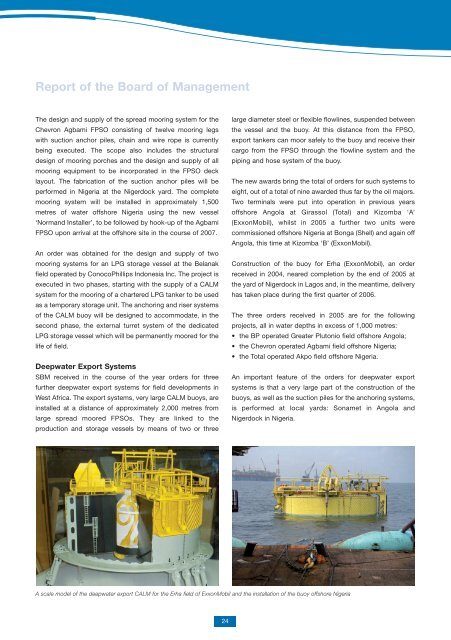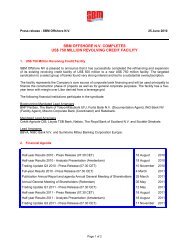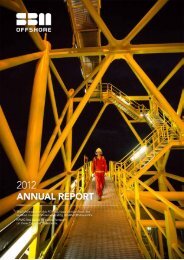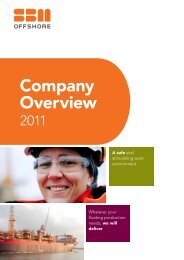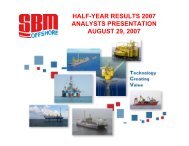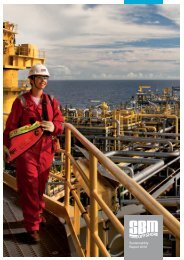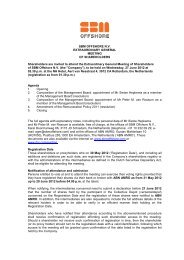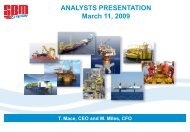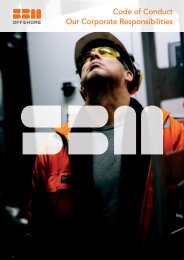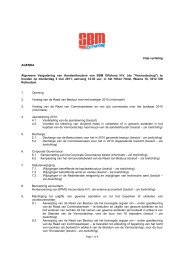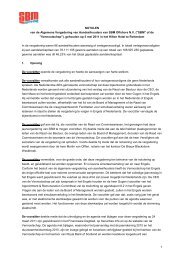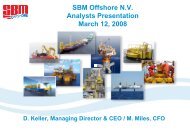2005 Annual Report - SBM Offshore
2005 Annual Report - SBM Offshore
2005 Annual Report - SBM Offshore
You also want an ePaper? Increase the reach of your titles
YUMPU automatically turns print PDFs into web optimized ePapers that Google loves.
<strong>Report</strong> of the Board of Management<br />
The design and supply of the spread mooring system for the<br />
Chevron Agbami FPSO consisting of twelve mooring legs<br />
with suction anchor piles, chain and wire rope is currently<br />
being executed. The scope also includes the structural<br />
design of mooring porches and the design and supply of all<br />
mooring equipment to be incorporated in the FPSO deck<br />
layout. The fabrication of the suction anchor piles will be<br />
performed in Nigeria at the Nigerdock yard. The complete<br />
mooring system will be installed in approximately 1,500<br />
metres of water offshore Nigeria using the new vessel<br />
‘Normand Installer’, to be followed by hook-up of the Agbami<br />
FPSO upon arrival at the offshore site in the course of 2007.<br />
An order was obtained for the design and supply of two<br />
mooring systems for an LPG storage vessel at the Belanak<br />
field operated by ConocoPhillips Indonesia Inc. The project is<br />
executed in two phases, starting with the supply of a CALM<br />
system for the mooring of a chartered LPG tanker to be used<br />
as a temporary storage unit. The anchoring and riser systems<br />
of the CALM buoy will be designed to accommodate, in the<br />
second phase, the external turret system of the dedicated<br />
LPG storage vessel which will be permanently moored for the<br />
life of field.<br />
Deepwater Export Systems<br />
<strong>SBM</strong> received in the course of the year orders for three<br />
further deepwater export systems for field developments in<br />
West Africa. The export systems, very large CALM buoys, are<br />
installed at a distance of approximately 2,000 metres from<br />
large spread moored FPSOs. They are linked to the<br />
production and storage vessels by means of two or three<br />
24<br />
large diameter steel or flexible flowlines, suspended between<br />
the vessel and the buoy. At this distance from the FPSO,<br />
export tankers can moor safely to the buoy and receive their<br />
cargo from the FPSO through the flowline system and the<br />
piping and hose system of the buoy.<br />
The new awards bring the total of orders for such systems to<br />
eight, out of a total of nine awarded thus far by the oil majors.<br />
Two terminals were put into operation in previous years<br />
offshore Angola at Girassol (Total) and Kizomba ‘A’<br />
(ExxonMobil), whilst in <strong>2005</strong> a further two units were<br />
commissioned offshore Nigeria at Bonga (Shell) and again off<br />
Angola, this time at Kizomba ‘B’ (ExxonMobil).<br />
Construction of the buoy for Erha (ExxonMobil), an order<br />
received in 2004, neared completion by the end of <strong>2005</strong> at<br />
the yard of Nigerdock in Lagos and, in the meantime, delivery<br />
has taken place during the first quarter of 2006.<br />
The three orders received in <strong>2005</strong> are for the following<br />
projects, all in water depths in excess of 1,000 metres:<br />
• the BP operated Greater Plutonio field offshore Angola;<br />
• the Chevron operated Agbami field offshore Nigeria;<br />
• the Total operated Akpo field offshore Nigeria.<br />
An important feature of the orders for deepwater export<br />
systems is that a very large part of the construction of the<br />
buoys, as well as the suction piles for the anchoring systems,<br />
is performed at local yards: Sonamet in Angola and<br />
Nigerdock in Nigeria.<br />
A scale model of the deepwater export CALM for the Erha field of ExxonMobil and the installation of the buoy offshore Nigeria


